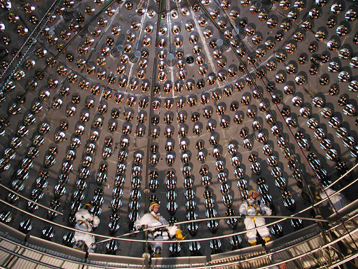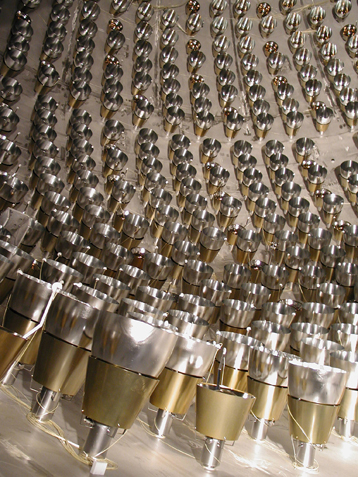
Over 99%, of solar energy comes from hydrogen fusion (fusion of protons) in the core of the star. This essential reaction transforms two protons into a deuterium nucleus, with the production of a positron and a low energy neutriono, referred to as a pp neutrino. The Borexino detector, installed in the Gran Sasso underground laboratory in Italy, has managed to measure directly for the first time the pp neutrino flux.
As soon as they are produced, the neutrinos cross the solar plasma in a few seconds, and arrive at the Earth 8 minutes later. On the other hand, the energy produced by this reaction at the same time as the neutrinos is carried by photons, and will thus take from one to two hundred thousand years to cross the dense solar material before reaching our planet. The neutrinos observed in this work are thus a direct probe of what is happening in our star today, while the solar energy which keeps us warm was produced long ago.
The experiment measured a neutrino flux of 6,6 × 10^10 neutrinos ear cm2 per second. This corresponds to a solar power of 3,98 × 10^26 watts, which is comparable to what is found from measurements of the solar energy reaching the Earth today (3,84 × 1026 watts). From these two figures it follows that the Sun is in complete thermodynamic equilibrium : its functioning has remained virtually unchanged for over a hundred thousand years. These results are in agreement with our current understanding of solar dynamics, and confirm that our star will continue to function as before for at least another hundred thousand years.

With this new measurement, the Borexino detector has been able to complete the spectroscopy of solar neutrinos and to obtain an unprecedented result. In effect, this detector is the only one able to measure the pp neutrino flux : these are the most numerous neutrinos, but also the most difficult ones to detect. Neutrinos are difficult to observe since their interaction with matter is very weak ; in the present case, an added difficulty is that the pp neutrino energy is very small. The Borexino detector is exceptionally efficient in eliminating the background noise which perturns low energy measurements It is placed under 1400 metres of rock, which absorbs cosmic radiation, while the advanced technology which was designed for this experiment eliminates as never before the effects of residual radioactivity (to a level of ten billion time less radioactivity than in a glass of water). These unique characteristics have led to this world première.
The Borexino experiment
The Borexino experiment is the fruit of a collaboration of several European countries (Italy, Germany, France, Poland), the U.S.A and Russia, and involves over 100 physicists, engineers and technicians. In France, scientists at the Laboratory for Astroparticles and Cosmology (CNRS/CEA/Paris Diderot University/Paris Observatory) joined the collaboration in 2000. They are supported by the IN2P3, by the Paris Diderot University, by the labex UnivEarthS, and by the APC laboratory.
References
Neutrinos from the primary proton-proton fusion process in the Sun, Borexino Collaboration : G. Bellini, J. Benziger, D. Bick, G. Bonfini, D. Bravo, B. Caccianiga, L. Cadonati, F. Calaprice, A. Caminata, P. Cavalcante, A. Chavarria, A. Chepurnov, D. D’Angelo, S. Davini, A. Derbin, A. Empl, A. Etenko, K. Fomenko, D. Franco, F. Gabriele, C. Galbiati, S. Gazzana, C. Ghiano, M. Giammarchi, M. Göger-Neff, A. Goretti, M. Gromov, C. Hagner, E. Hungerford, Aldo Ianni, Andrea Ianni, V. Kobychev, D. Korablev, G. Korga, D. Kryn, M. Laubenstein, B. Lehnert, T. Lewke, E. Litvinovich, F. Lombardi, P. Lombardi, L. Ludhova, G. Lukyanchenko, I. Machulin, S. Manecki, W. Maneschg, S. Marcocci, Q. Meindl, E. Meroni, M. Meyer, L. Miramonti, M. Misiaszek, M. Montuschi, P. Mosteiro, V. Muratova, L. Oberauer, M. Obolensky, F. Ortica, K. Otis, M. Pallavicini, L. Papp, L. Perasso, A. Pocar, G. Ranucci, A. Razeto, A. Re, A. Romani, N. Rossi, R. Saldanha, C. Salvo, S. Schönert, H. Simgen, M. Skorokhvatov, O. Smirnov, A. Sotnikov, S. Sukhotin, Y. Suvorov, R. Tartaglia, G. Testera, D. Vignaud, R.B. Vogelaar, F. von Feilitzsch, H. Wang, J. Winter, M. Wojcik, A. Wright, M. Wurm, O. Zaimidoroga, S. Zavatarelli, K. Zuber and G. Zuzel, Nature, 28 août 2014.

![<multi>[fr]pdf[en]pdf</multi>](IMG/gif/pdf.gif)